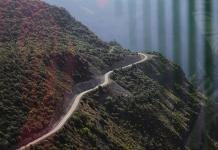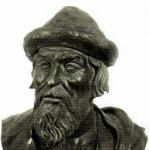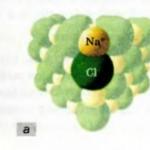MINISTRY OF CULTURE OF THE RSFSR
Russian republican specialized
scientific restoration association
"Rosrestavratsiya"
Design Institute for the Restoration of Monuments
history and culture "Spetsproektrestavratsiya"
INSTRUCTIONS
FOR PAINTING FACADES
LIME COMPOSITIONS
Moscow - 1982
The instructions are intended for engineering and technical workers and production personnel of special scientific and restoration production workshops and other organizations carrying out work on painting facades.
The instructions are standard and should be used taking into account the specifics of a particular monument.
These instructions were developed by an employee of the restoration technology department of the Spetsproektrestavratsiya Institute.
The instructions were prepared for printing by an employee of the NTI sector of the technical department.
The instructions were approved by the scientific and restoration council of the Rosrestavratsiya association on June 23, 1982.
INTRODUCTION
The most common traditional paint for finishing the facades of architectural monuments in the 17th-19th centuries. was lime paint based on low-magnesium lime.
Coatings based on lime paint have a number of decorative advantages and are distinguished by their velvety, brightness and purity of color (I).
In the last 2-3 decades, magnesian and dolomitic lime has been used in lime paints instead of low-magnesium lime, which results in a short service life of façade lime paint.
To increase the service life of coatings based on magnesium and dolomite lime, it is necessary to introduce special additives into the paint composition (paraffin, aluminum alum, hydrophobic compounds) or treat them with water-repellent compounds.
1. GENERAL PROVISIONS
1.1. All types of work on painting the facades of architectural monuments are carried out as the last stage of the entire complex of restoration work.
1.2. Work on painting facades should be carried out after a detailed study of the paint layers present on the facade and establishing their color and composition, identifying the original paint layer (or the paint layer for the restoration period), as well as after determining the salinity of the masonry and plaster layer.
1.3. Work on the facades of architectural monuments is carried out in most cases using the method of complete reconstruction, and at the same time, improvements in technology and the use of modern materials are often allowed.
1.4. Painting technology includes surface preparation, preparation and application of paint compositions,
1.5. All materials necessary for surface preparation and painting must have passports or a laboratory conclusion for compliance with GOST or TU, since the durability of the paint depends on the quality of the materials.
In lime paints, low-magnesium lime should be used (2).
1.6. Painting facades with lime paints should be done at positive temperatures in non-hot times in the absence of direct sunlight (3.4).
1.7. The service life of a modern lime coating, subject to the painting technology, is ~ 3-4 years (3)
1.8. To increase the service life of the coating to 5-7 years after painting, it is necessary to carry out 2-time treatment with 3-5% aqueous solutions of organosilicon liquids GKZh-10 (or GKZh-11) or a 5% solution of resin 174-71 (old resin grade K-I5/3) in white spirit (5) or add a 3-5% aqueous solution of GKZh-10 (or GKZh-11) to the paint composition.
Note : Treatment with organosilicon compounds can be carried out if the total surface salinity (at a depth of up to 2 cm) of the brickwork and plaster layer does not exceed 3% (salinity determination is carried out by the laboratory).
1.9. All work on surface preparation, preparation and application of painting compositions to the facades of historical and cultural monuments should be carried out only by specialized scientific and restoration workshops.
2. PREPARATION OF THE SURFACE FOR PAINTING
2.1. The durability of facade coatings is largely determined by the quality of surface preparation before painting.
2.2. Painting work should be carried out after restoration of the brickwork (repairing, replenishing losses and strengthening) using thin-layer lime coating or plaster.
The surface must be strong, smooth and free of dirt and other impurities.
2.4. If the plaster layer is durable and does not require restoration, the surface should be cleaned of old paint and washed thoroughly with water. If there is a strong build-up and there are defects after cleaning, the surface is rubbed with the following composition:
Lime dough (grade 1 lime) - 1 c. h.
Fine sand (washed from soluble impurities) - 1.2 c. h.
2.5. Before applying lime paints, the surface should be wetted with water until it is damp.
2.6. After preparing the surface, an act for hidden work is drawn up with the participation of the leading architect (or technologist), who must give permission for painting.
2.7. Before carrying out surface preparation work, you should, together with the leading architect, select small areas (10x10 cm in size) - “marks” - with well-preserved original plaster and paint layers and record their location in the hidden work report, or leave the “marks” unpainted.
No surface preparation (except for cleaning wads) is carried out in these areas.
3. SELECTION OF PIGMENTS
3.1. All natural and most artificial mineral pigments are suitable for lime facade paints.
Natural pigments include ocher, mummy, red lead, sienna, umber, manganese peroxide, brown manganese, gray and colored slates, tuffs, malachite, etc.
Artificial mineral pigments - titanium white, strontium yellow, English red, cadmium red (without discolouration), mars of all colors, cobalt blue 255, cobalt blue 286 and 609, cobalt green, ultramarine sulfate, chromium oxide, emerald green, burnt bone, grape black.
3.2. All pigments should first be tested for their resistance to lime by shaking them in a glass with a lime solution. In this case, the color of the paint should not change within 2 days compared to a sample of the same color prepared in water with chalk.
4. RECIPE, PREPARATION AND APPLICATION
PAINTING COMPOSITIONS
4.1. As a primer for lime paints for compositions No. 1 and No. 2 (see Table 1), a 10-liter lime soap maker of the following composition is used:
lime-boiler - 1.2-2.0 kg
solid laundry soap - 0.15-0.2 kg
drying oil - 0.025-0.03 kg
water - up to 10 liters
Lime is slaked with three times the amount of water. Soap is dissolved separately in 0.5 liters of hot water. Drying oil is added to the soap solution with thorough mixing in small portions. The resulting emulsion is gradually introduced during slaking into boiling lime with thorough mixing. The finished composition is diluted with water to a volume of 10 liters.
Note : when using composition No. 3, the surface is not primed with soap.
4.2. If necessary, partial lubrication of embroidered cracks is carried out with a paste of the following composition:
Gypsum - I kg
Chalk - 2 kg
256th aqueous solution of bone glue - to a working consistency (1.5-2 l).
The gypsum is mixed with a small amount of a 2% water-adhesive solution, and then chalk is added to it and brought to working viscosity by adding the adhesive solution.
The paste is applied with a spatula. After the paste has dried, it is polished.
4.3. Lime paints can be prepared using boiling lime, lime paste or hydraulic lime.
4.4. Recipes for lime paints are given in Table 1.
Table 1
4.5. Preparation of lime paints
Recipe I . The pigment is soaked in water for 24 hours. Lime dough is diluted in 3-5 liters of water and mixed with a solution of table salt. Add pre-soaked pigment to the mixed solutions and dilute with water to a volume of 10 liters.
Recipe 2 . The boiling lime used is quenched at different rates (Table 2). In cold weather and, mainly, when the lime slaks slowly, it is recommended to slak it with hot water (t = 60°C). The specific gravity of the resulting milk is checked with a hydrometer and should be equal to 1.111
table 2
Recipes 3 . First, lime soap of the following composition is prepared for 10 liters of composition:
Air-boiling lime - 3.3 kg
Natural drying oil - 0.2 kg
Water, up to - 10 l
In this case, the lime is quenched and at the moment of strong heat generation, drying oil is introduced into it.
When preparing paints, all components are introduced in the sequence in which they are listed in Table 1, except for recipe No. 3, where lime soap is first introduced, then table salt and pigment, previously (24 hours before) soaked in water. The finished composition is passed through a sieve with 1600 holes/cm². The shelf life of the composition is 24 hours.
4.6. A test coloring is carried out on a small area with the prepared color. The color shade must correspond to the passport and be approved by the author of the project (or architect). Then painting is done.
Lime paints are applied 2 times using a brush or spray gun on a moistened surface.
During the entire painting period, it is necessary to keep the surface moist by wetting it abundantly with water.
Types of defects when painting with lime paints and methods for eliminating them are given in Appendix 1.
5. HYDROPHOBIZATION WITH RESIN SOLUTION 174-71
5.1. The hydrophobizing working composition is a 5% solution of organosilicon resin 174-71 in white spirit.
5.2. Commercially produced silicone resin is an 8056 solution in toluene.
5.3. A strengthening, hydrophobizing and antiseptic composition based on resin 174-71 can be applied to the surface at a temperature not lower than 5°C and no earlier than 7 days after painting with lime paints, all devices and tools accepted for restoration (spray gun, soft brush, etc.) . P.). The composition is applied 2 times. Drying the 1st layer - 1 hour. The hydrophobic effect - “water repellency” - appears 2 days after application. During this time, the coating should be protected from moisture. The approximate consumption of resin 174-71 per 1 layer per 1 m², taking into account application losses, is 10 g of resin or 150 g of working solution.
Calculation of the amount of resin in the 556th solution:
specific gravity of white spirit - 0.77 g/cm3
specific gravity of resin 174-71 - 1.093 g/cm3
For 1 kg of solution, take 62.6 g of resin 174-71 and 937.5 g of white spirit or 57 ml of resin and 1207 ml of white spirit.
The solution is prepared in a dry, clean container (glass or enamel). The solution should be prepared in an amount that can be used within one day.
The materials used, GOSTs and specifications are given in Appendix 2.
6. HYDROPHOBIZATION WITH 3-5% AQUEOUS SOLUTIONS OF ORGANOSILONE LIQUIDS GKZH-10 OR GKZH-11
Surface hydrophobization
6.1. Hydrophobization of a surface painted with lime paints is carried out with aqueous solutions of organosilicon liquids GKZh-10 or GKZh-11.
Working solutions GKZh-10 and GKZh-11 are diluted with water at a temperature not lower than +10°C of the commercial solution, depending on its concentration and the required concentration of the working solution.
6.2. Table 3 shows the amounts of liquid required to prepare 10 kg of GKZh working solution at different dry residues.
Table 3
6.3. Before preparing working solutions, the initial compositions of GKZh are brought into a warm room 6 hours before they are diluted.
6.4. Working solutions should be prepared in quantities not exceeding the 4-hour requirement.
If it is necessary to store solutions for a longer time (3-4 days), they should be placed in well-sealed steel or glass containers.
6.5. Solutions of liquids GKZh-10 and GKZh-11 can be applied no earlier than 6 days after painting with lime paints at an air temperature not lower than +10°C.
Liquids are applied with a paint sprayer (application with a brush is allowed) in 2 times. Dry each layer for 48 hours.
During this time, the coating should be protected from moisture.
6.6. The liquid solution consumption is ~500-600 g/m²
Commercial liquid consumption ~100 g/m²
6.7. The guaranteed shelf life of liquids GKZh-10 and GKZh-11 in a warehouse is 6 months.
Manufacturer: chemical plant, Dankov, Lipetsk region. Cost - 0.65+0.70 rub. for I kg.
Volumetric hydrophobization
6.8. Liquid GKZh-10 (or GKZh-11) can be directly introduced into the paint composition in the form of a 3% aqueous solution of GKZh-10 or a 3-5% solution of GKZh-11. This solution should be used when preparing lime paint (instead of water) for the 2nd (last) coat of paint.
7. SAFETY REQUIREMENTS
7.1. When working with materials containing toxic solvents (toluene, white spirit, etc.), their preparation and storage, it is necessary to comply with all current safety regulations stipulated by the “Safety Rules for Construction and Installation Works”, approved by the Central Committee of the Construction Workers Trade Union and industry November 26, 1958, PBVHP-74 and the head of SNiP Sh-A. P-70(6).
Particular attention must be paid to meeting the requirements set out in the following paragraphs.
7.2. Persons at least 18 years of age who have been instructed about the hazards of these materials and safety measures when working with them are allowed to work with paints and varnishes containing xylene, toluene, and solvents. Instructions are carried out at least 2 times a month.
7.3. The preparation of working compositions must be carried out in a special room provided with good ventilation.
7.4. Where materials are stored, the container must have a label or tag with the exact name of the material.
7.5. The amount of materials located at the work site should not exceed shift requirements. Containers containing materials and solvents must be hermetically sealed. Storage and transportation of materials in open form and glass containers is prohibited.
7.6. Smoking, the use of open flames, and work that causes sparks are strictly prohibited near the painting work sites.
7.7. Vapors of toluene, white spirit, etc., which are part of water-repellent materials, when inhaled or absorbed through the skin, can cause general poisoning or local skin damage. Therefore, when working with such materials, workers must be equipped with special clothing (overalls, rubber aprons, rubber gloves, mittens, boots), as well as respirators of the F-46K brand with a replacement box of the A brand and safety glasses of the PO-2 type. (see PBVHP-74).
7.6. To protect the skin of your hands, you must use ointments and pastes, the compositions of which are given in Table 4.
Before using the paste, hands should be washed with warm water and soap and thoroughly wiped dry. Then 6-8 g of the paste are rubbed between the palms, after which the paste is rubbed into the coca evenly over the entire surface of the hand.
Within a few minutes the paste dries, forming a dry coating. After working with paints and varnishes, the pastes are washed off with soap and water.
7.9. It is prohibited to eat food or store outerwear in areas where water-repellent compounds are prepared and applied.
7.10. After finishing work with water-repellent materials, taking a hot shower is mandatory.
7.11. All workers who constantly deal with toxic compounds must undergo periodic medical examinations, in accordance with Order No. 000 of the USSR Ministry of Health dated January 1, 2001.
Table 4.
Components | Paste name |
||
Invisible | Film-forming cream |
||
Technical ethyl alcohol | |||
Technical glycerin | |||
Ethyl ether | |||
Distilled glycerin | |||
Polyvinyl alcohol | |||
Aqueous technical ammonia | |||
Titanium dioxide | |||
Emulsion wax | |||
Fragrance "0AJI-I" | |||
Preservative | |||
Sodium carboxymethylcellulose | |||
Special liquid soap | |||
Water (or steam condensate) | |||
TU 6-15-32-02-76 | TU-47-7-4K/68 |
||
Manufacturer | Kazansky pharmaceutical | Novomoskovsk Household Chemicals Plant |
Annex 1
Defect | Cause | Elimination |
Various shades of color | 1. Different absorbency of the primed surface | 1. Clean the surface from the paint layer and prime it with a high-quality primer |
2. External influences during painting (sun, wind, etc.) | 2. Follow the technology and painting regime |
|
Brush marks | Consistency too thick | Thin the paint |
Peeling of paint film | 1. Paint is applied to a surface previously painted with foreign paint (emulsion, etc.) | 1. Clean the surface of old paint and grind |
2. Thick coat of paint | 2. Apply paint in a thinner layer |
|
Low hiding power | The paint is too thin | Change paint consistency |
Grainy surface | 1. The paint is poorly strained. | 1. Strain through a 0-26A vibrating sieve (900 holes/cm²) |
2. Dust has gotten onto the primed surface. | 2. Remove dust |
Applications 2
LITERATURE
1. . Practice of restoration work. Second collection, ed. and State ed. literature on construction, architecture and building materials, M., 1958.
3. . Paint and varnish technology in architecture. A reference guide for architects and builders. M., State architect ed. Academy of Architecture of the USSR, 1941.
4. . Repair and painting of building facades. M., Stroyizdat, 1971.
5. , . Properties and areas of application of organosilicon products, M., 1975.
6. . . Occupational safety when applying paint and varnish coatings in mechanical engineering. M., "Mechanical Engineering", 1981.
It is obtained by burning mountain limestone in specially equipped kilns. As a result of the thermal process, the output is lumps of lime of different sizes, which retain their strength in the air. Lime has been used in construction for quite a long time; extinguishing lumps with water allows them to dissolve, resulting in a white solution.
Lime is one of the most inexpensive materials for redecorating premises. Lime solution is used both for whitewashing the interior of the house and for outbuildings.
The benefits of using lime include:
- Low cost, experts rate the price of lime in lumps as five points; it is quite difficult to find a cheaper and at the same time high-quality finishing material.
- Lime has antimicrobial properties, that is, bacteria that get on its surface die. These properties of the raw material successfully make it possible to whitewash with lime in rooms for pets and outdoor toilets.
- Lime is moisture resistant and does not crack due to temperature changes. Walls treated with slaked lime are not afraid of fungus and mold; these microorganisms simply do not settle on this raw material.
- The natural material is safe for health, it does not have a strong odor and does not emit substances harmful to breathing; on the contrary, after using lime, the room is partially disinfected.
- This material can be applied both to old whitewash and to new walls.
During the whitewashing process, after the layer of lime dries, a special film is formed on its surface, which prevents fading and increases the resistance of the walls to abrasion.
Another feature of slaked lime is its good miscibility with dyes, that is, as a result of diluting the raw material with paint, any shade can be obtained.
How to properly slak lime at home
It is best to purchase lime for planned repairs in the form of lumps. Such raw materials are preserved for quite a long time, and they can be prepared for use in a short time. In order for the dilution to result in a solution that is satisfactory in terms of concentration and homogeneity, you need to know the basic rules for preparing it and be sure to follow safety precautions when working.
Rules for extinguishing lumps of lime at home:
- For whitewashing walls and ceilings, so-called lime milk is used. It is easy to prepare - you will need one part lime and about three parts cold water.
- Large lumps of lime should be crushed, but not into crumbs, and placed in a metal container.
- Water is poured into a container with lime; the solution must be stirred.
- After contact with water, a dissolution reaction occurs during which the lime may bubble and splash. Therefore, in the first 10-20 minutes, the container must be closed or moved to a safe distance. It is a good idea to use safety glasses and gloves, as splashes of the solution can cause burns.
- The prepared lime should sit for at least 6 hours, during which time it will completely dissolve.
- After preparation, the solution is filtered through a sieve. Thus, all undissolved elements and small debris are removed.
- Lime milk is completely ready for use. To increase strength and to prevent lime on the walls from staining clothes in the future, experts advise adding ordinary salt and drying oil to the solution. The amount of drying oil and salt is chosen from the volume of the resulting solution; 100 grams of both are sufficient for 10 liters.
If the solution turns out to be thick, then it can be diluted with water to the required proportions. Tint dyes are introduced in dissolved form; in order to give the lime an exceptionally snow-white appearance, it is recommended to add a little blue.
Slaking lime is not a labor-intensive process, but not safe. When slaking lime, you must follow safety precautions. Extinguish in the open air, in free space, always wearing glasses, gloves and special clothing:
Whitewashing equipment
Whitewashing can be done in different ways. Previously, there was only one way to distribute lime over surfaces - using brushes. Modern technologies make it possible to reduce the time spent on renovations using lime milk; a brush is now most often used if you need to whiten small surfaces.
You can make your work easier using the following devices:
- The spray gun can be manual, electric or pneumatic. If you are not going to process large surfaces, then the most economical option would be to buy a manual type of spray gun. The principle of operation of the devices is similar: one hose of the device is immersed in the solution, through it the lime is taken and fed through the accumulator into the other hose. At the end of this hose there is a nozzle, it is through it that the lime is released. The size and speed of the jet can be adjusted. You can buy a manual spray gun from about one and a half thousand rubles; electric versions of the device cost an order of magnitude more. Using a spray gun simplifies painting work; whitewashing with its help is carried out much faster, while the supplied jet easily penetrates hard-to-reach places.
- The lime whitening machine is used to treat large surfaces. Its operating principle is the same as that of a spray gun; its capacity can be up to 100 liters.
- A spray bottle for whitewashing can be used the same one that is used for spraying plants. Only its capacity should be in the range from 5 to 15 liters.
Any devices for mechanizing the whitewashing process can reduce repair time and ensure uniformity of lime layers. The labor intensity when using them is minimal, any person can understand the structure of the device and its principle, and it becomes possible to paint high ceilings without using a stepladder.
When using spray guns, lime consumption is also reduced, since large drops do not fall on the floor and furniture. The only condition is to use a high-quality solution without impurities or lumps, otherwise the device may clog and fail.
This is what the equipment listed above looks like
 Manual spray gun Electric spray gun Spray gun for whitewashing Apparatus for whitewashing
Manual spray gun Electric spray gun Spray gun for whitewashing Apparatus for whitewashing
Do-it-yourself whitewashing rules
To process the desired surfaces with lime, no special skills are required; even using this material for the first time, you can easily learn during the work process. But it is still necessary to take into account some nuances and then the repair will be fast, safe and of sufficient quality.
Whitewashing the walls
Walls can be whitewashed with lime both indoors and outdoors. Whitewashing the outside of a house is most quickly done with a spray gun. In order for the lime to adhere well, not change its color and not swell, it is necessary to first prepare the walls.
Rust stains, dirt, and greasy areas are removed from surfaces. If there are cracks, they need to be treated with a primer; good adhesion of the lime to the walls is ensured by treating them with a metal brush. Lime does not adhere to paint, so the layer of old paint must be removed.
Whitewashing is best done in cloudy weather; bright sunlight distorts perception and does not allow you to achieve even strokes. When using a spray gun, you need to hold it at an angle of 90 degrees to the wall, this will ensure less consumption of the solution and evenness of its application.
The video shows how you can whitewash walls with lime using a spray gun:
Whitewashing the cellar
Using lime to treat all surfaces in a cellar intended for storing food is considered the best option. Lime destroys all microorganisms, disinfects the room, prevents the appearance of fungus, due to these factors the shelf life of products increases, vegetables do not rot. Lime is resistant to moisture, so it protects the walls of the cellar from moisture.
The cellar is whitewashed with a fairly thick solution of lime; you can use both spray guns and brushes. Spraying devices are usually used in large areas, but when using them, safety precautions must be observed.
The spray gun creates clouds of tiny lime particles; in a closed space, such as a cellar, this cloud negatively affects the mucous tissue of the respiratory organs and eyes. To avoid harm to the body, you need to wear glasses and a respirator that fit tightly to your face.
If the cellar is being whitewashed for the first time, then it is advisable to apply a second coat after applying the first layer and drying it.
Whitewashing the stove
Some private houses, dressing rooms and other premises have brick walls. Whitewashing with lime is the most practical option for quickly repairing them. The surfaces of the stove quickly become dirty with soot and grease and therefore require regular updating.
Lime can be used at any time, especially since a brush can also be used for small surfaces. In order for the solution to be smooth and easy, the oven must be cooled and all greasy stains must be removed with sandpaper or a scraper.
How to whitewash and decorate a stove with lime can be seen in the photo below
Oven No. 1 Oven No. 2 Oven No. 3 Oven No. 4 Oven No. 5
Whitewashing the facade
The easiest way to whitewash the facades of buildings and houses is to use spray guns. Windows, doors, decorative elements need to be closed, and whitening should begin from the highest points, moving down. It is advisable to whitewash external walls in calm, cloudy weather.
Whitewashing the ceiling
Separately, whitewashing the ceiling with lime is carried out if the remaining walls have wallpaper or other finishing material. If you plan to change the wallpaper, you must first remove the old ones, then whitewash the ceiling and only then re-paste the walls. All old coverings need to be removed from the ceiling, cracks must be repaired, and dirt must be cleaned. Rust and mold can be easily removed with a solution of copper sulfate.
Lime milk applies most easily and evenly to a wetted surface, so it is advisable to moisten the ceiling. After preparing the ceiling, you need to cover the floor, furniture, and windows with waterproof materials, since lime splashes well and is difficult to wipe off when dried.
The ceiling is whitewashed in two layers. The first layer begins to be applied from the window, making strokes perpendicular to the light. The second layer is applied to the still wet first, strokes are made parallel to the sun's rays. This whitewashing technology ensures the adhesion strength of the lime and the absence of streaks.
Repair lessons or how to whitewash a ceiling with your own hands:
Tree processing
Whitewashing tree trunks with lime solves several problems at once and is carried out in the spring and autumn. Treating trees in the spring protects the wood from pests and prevents the sun's rays from burning the bark. In autumn, lime is used to reduce the impact of temperature changes in winter.
Grown trees are whitewashed; young plants are not treated, since lime clogs the pores of the bark and thereby disrupts the growth processes. Before processing, you need to remove all dried parts and clean areas with rotting bark.
For whitewashing, lime is used in combination with copper sulfate. Two kilograms of lime are diluted with 10 liters of water, after preparation, 400 grams of vitriol are added to the solution.
Chicken coop treatment
Whitewashing the chicken coop allows you to disinfect the room. It’s even better if the lime slaking is carried out in the chicken coop itself, naturally without its inhabitants. The vapors released when lumps of lime are dissolved penetrate well into all cracks and destroy bedbugs, ants and other small insects.
In summer, it is advisable to whitewash the walls in the chicken coop at least twice, this will interrupt the breeding chain of many insects. Additionally, before whitewashing, walls can be treated with a weak bleach solution. The practicality of using lime for treating animal premises is rated 5 points; it is an inexpensive material, environmentally friendly and has the most optimal disinfection properties.
Consumption for whitewashing
Lime milk is usually used to whitewash walls and ceilings in a house. The consumption of lime for every 2.5 square meters is approximately 0.5 kg of lumps of lime, diluted in the appropriate proportion with water.
Features of painting and putty on lime

If you apply lime milk directly to a layer of water-based paint, it may happen that the quality of the repair will not satisfy you.
The lime adheres to the paint and runs with it, and once it dries, it is likely to cause blistering.
To prevent this, you must first wash the surfaces with paint with soap and water and a brush and then treat them with a stiff brush for better adhesion of the compounds.
Putty is used during repairs to ensure a good leveling of the surface. If you plan to putty on walls covered with lime, you must first remove the old layer. Alternatively, you can remove all swollen areas with a scraper and apply a primer, after which the lime can be easily removed.
How to remove lime from floors and walls
During the process of whitewashing surfaces with lime, stains inevitably remain on all surfaces. The easiest way to remove them is while they are still fresh; this will require water and a sponge; treatment with water is carried out several times, this allows you to remove all the white stains.
If a layer of old lime needs to be removed to apply other materials during repairs, then the following points must be adhered to:
- Wet all desired surfaces with water using a brush or spray gun.
- Wait until thoroughly wet, then remove the lime with a hard, metal sponge or scraper. If there are several layers of lime, you will have to wet it several times and also use paper clips several times.
- If you are not afraid of dust in the room, then the process can be speeded up by using an angle grinder with a special attachment.
- It is imperative to use goggles and a respirator, since dust during work can negatively affect the eyes and the condition of the respiratory tract.
The removal of old lime can be facilitated by the use of special liquid products, under the influence of which the whitewash layer dissolves and easily comes off from surfaces.
These include:
- Guard Industry product
- Decap' Sols Plus Guard.
- Tool Space.
All products contain acid, so you need to protect your hands and eyes. Some people also use diluted hydrochloric acid, but since it is hazardous to health, it is not recommended for use.
Prices for whitewashing
Using whitewash is considered the most inexpensive repair option. Construction crews also charge minimal amounts for whitewashing. Typically, whitewashing walls with an area of one square meter and using one layer starts from 50 rubles.
Naturally, the cost varies greatly and depends on many factors - surface contamination, cleaning application, application of lime in several layers. If you know your square footage, then it will not be difficult for you to calculate the approximate cost of all the work.
In conclusion, we suggest watching a video - useful tips from Professor Chainikov when whitewashing:
The preparation of surfaces for decorative lime paints can be different. The best base should be considered a plastered surface with a covering layer prepared on fine-grained sand (Lyubertsy type with a grain size of 0.2-0.3 mm). When preparing previously painted surfaces, they must be cleaned of deposits and rubbed with a solution, also prepared with fine-grained sand.
Sometimes you can prepare surfaces for painting by applying a thin layer of putty (on the strip). In this case, you should use lime-cement putty prepared according to the following recipe.
5. Composition of putty for lime paints
kg
Filler (marble flour, sand), sifted on sieves No. 0.16 and 0.5 ....... 4.0—5.0 "
Cooking method. The components are introduced into the mortar mixer and mixed until homogeneous.
The viscosity of the composition is checked by immersion of a standard cone and should be equal to 6-8 cm with manual application and 11-12 cm with mechanized
The putty composition is applied using spatulas or a mechanized pneumatic installation SO-21. Excess composition is removed with spatulas.
To create the necessary conditions for crystallization and carbonization of the lime binder, the surfaces are abundantly moistened before puttying, and puttying begins on the wet plaster, which has restored the pulling ability. Freshly moistened plaster should have a matte appearance.
Inextricably linked with the painting of surfaces is their primer. The primer composition is applied to a moistened surface, which has restored its pulling ability after wetting with water, and the color composition is applied to a fresh primer layer, which has also just restored its pulling ability.
It is believed that if the surface loses its wet shine, it means that the pulling ability has been restored.
Wetting, priming and painting of surfaces is carried out using a spray gun, with a viscosity of color compositions no higher than 15-16 sec according to VZ-4 and spray guns or brushes at higher viscosity. When working with brushes, the color is applied after the primer layer has dried for some time. Drying time depends on the temperature and humidity conditions of the room.
When finishing facades, work should not be carried out in rain and wind, as well as in direct sunlight.
Lime primers and paints are produced with compositions prepared with airborne low-magnesium lime according to the following recipes:
6. Composition based on lime paste (in kg)
Table salt...... 0.1
Cooking method. Lime paste is diluted 2-3 l water. Table salt is dissolved separately in 1 l water and, stirring, pour into the lime dough. Then pigments, previously ground in water, are introduced into the resulting composition. The composition is diluted with water to a volume of 10 l and filtered on a CO-3 vibrating sieve with a mesh of 0.25-0.2.
7. Composition based on air-lime-boil (lumpy or ground) (in kg)
Table salt...... 0.1
Pigments (alkali-resistant) ....... no more than 0.3
Cooking method. Lime-lime is quenched with triple (by weight) amount of water, in one of the following ways:
a) quickly slaking lime is poured so that it is covered with water. When boiling, the solution is stirred and water is added until the release of vapors stops;
b) medium-slaking lime is filled with water up to half. At the beginning of boiling, the lime is stirred, gradually adding water until the boiling stops;
c) slowly slaking lime is first only moistened with water, and when it begins to boil, water is slowly added until the vapors cease to be released.
In cold weather, it is better to slak lime, especially slow-slaking lime, with hot water.
When slaking stops, table salt diluted in a small amount of water and pigments ground in water are added to the lime. Then the composition is mixed and water is added to a volume of 10 l. The finished composition is filtered on a CO-3 vibrating sieve With mesh No. 0.25—0.2.
8. Composition based on air-lime-boil (lumpy or ground) (in kg)
Lime-boiling...... 1.2-1.5
Natural drying oil...... 0.06—0.12
Pigments (alkali-resistant) ....... no more than 0.3
Cooking method. The lime is quenched as indicated in recipe 7, but during the period of the strongest steam release, drying oil is introduced into the lime and mixed thoroughly. Then the composition is diluted with water to a volume of 10 l and filtered on a CO-3 vibrating sieve With mesh No. 0.25—0.2.
9. Composition based on lime test with ammonium chloride (in kg)
Lime dough containing 50% water....... 2.5-3
Ammonium chloride (ammonia) ....... about 0.2
Pigments (alkali-resistant) ....... no more than 0.3
Cooking method. Lime paste with pigment is diluted to a volume of 10 l 3% aqueous solution of ammonium chloride (10 l water 300 G ammonium chloride). The finished composition is filtered on a CO-3 vibrating sieve with a mesh size of 0.25–0.2.
10. Composition based on lime test with aluminum-potassium alum (in kg)
Lime dough containing 50% water....... 2.5—3.0
Aluminum-potassium alum....... 0.2
Pigments (alkali-resistant) ....... no more than 0.3
Cooking method. The composition is prepared according to recipe 9.
11. Composition based on lime test with alumina sulfate (in kg)
Lime dough containing 50% water....... 2.5-3.0
Alumina sulfate (technical) ....... 0.25
Pigments (alkali-resistant) ....... no more than 0.3
Cooking method. Lime paste with pigment is diluted to a volume of 10 l 3.5% alumina solution (10 l water 350 G alumina). The finished composition is filtered on a CO-3 vibrating sieve with a mesh size of 0.25–0.2.
The compositions listed in recipes 6-11 can be used for priming and final painting.
Painting with lime paste compositions is carried out with brushes or using paint spray guns with a nozzle with a hole of 3-4 mm and a nozzle with a slot-shaped hole. When painting, the spray gun is moved parallel in vertical or horizontal directions. When painting with hand brushes, the composition is applied using the “brush to brush” method. Breaks when painting interior spaces are allowed only after painting the entire room or finishing painting to a corner or any architectural division, and when painting facades - at the boundaries of an architectural division or at drainpipes.
Paste lime compositions are prepared according to the following recipes:
12. Composition based on lime test
Lime dough 50%....... 1.5—2.0 kg
Portland cement grade 400 ....... 0.5—1.0 "
Pigments (alkali-resistant) ....... no more than 0.6 "
Filler (marble flour, sand), sifted on sieves No. 0.16 and 0.5 ....... 4.0–5.0 » Water..... 3.0–4.0 l
Cooking method. The composition is prepared in the same way as according to recipe I, but for a 3-4 hour requirement. Before use, the composition is filtered on a sieve No. 0.25. The viscosity of the composition is determined using a standard cone, which should be immersed 12-13 cm.
13. Composition based on fluff lime
Fluffy lime...... 0.66 kg
Portland cement grade 400 ....... 1.0 "
Dolomite flour...... 1.67 »
Fine quartz sand....... 1.0 "
Pigments (alkali-resistant) ....... no more than 40% by weight of lime and cement
Water......until working consistency
Cooking method. The dry part of the composition is mixed in a mortar mixer in the following sequence: first, the binder with pigments, then the resulting mixture with dolomite flour and sand. Before use, add water to the dry mixture, preparing the working mixture for no more than an hour’s requirement. The consistency of the composition is determined by immersing a standard cone. The immersion value should be 12-13 cm.
14. Composition with microasbestos
Hydraulic lime fluff....... 2.5 kg Quartz sand, sifted through a sieve with 400 hole/cm 2....... 2.5"
Microasbestos (grade 6-7 fiber) ....... 0.8 "
Pigments (alkali-resistant) ....... 0.6
Water......until working consistency
Cooking method. The composition is prepared in the same way as in recipe 13.
The number and sequence of painting operations with aqueous compositions depend on the type of surface, paint composition and requirements for the quality of the painted surface. Technological operations performed during the preparation and painting of indoor surfaces with aqueous compositions are given in the table.
Technological operations |
Coloring |
||||||
adhesive |
limestone |
silicate |
emulsion |
||||
simple |
improved |
high quality |
for plaster and concrete |
on wood and brick |
|||
|
Surface cleaning |
|||||||
|
First priming |
|||||||
|
Filling cracks and sinkholes |
|||||||
|
Sanding greased areas |
|||||||
|
First full putty |
|||||||
|
Grinding |
|||||||
|
Second full putty |
|||||||
|
Grinding |
|||||||
|
Second primer |
|||||||
|
Third primer with tint |
|||||||
|
Coloring |
|||||||
Note. Sign " + " indicates the operations being performed, and the sign " - " indicates that this operation is not performed.
Painting with adhesives begin only after the last layer of primer has dried, no later than 24 hours after its application. In this case, the painting compositions are applied twice. When painting by hand, paint brushes, fly brushes and rollers with covers made of foam rubber or sponge rubber are used.
For painting the ceiling compositions with less glue are used. Ceilings are usually painted in two stages. The first painting is done with brushes, and the movement of the brush should correspond to the direction of the light falling from the window (Fig. 1). When the first layer dries, the surface is covered with a second thin layer of color from a spray gun.
Figure 1. Direction of painting surfaces
When painting a surface with a hand spray gun(Fig. 2) the work is carried out by two painters: one directly performs the painting, and the second pumps the coloring composition into the spray gun cylinder. The container holds 3 liters of paint composition. Two hoses are connected to the spray gun cylinder - pressure and suction, as well as a fishing rod with a nozzle. Before starting work, it is necessary to check the tightness of the connections. The suction hose is lowered into a container with a paint composition. The cylinder itself contains a plunger pump and two ball valves. When the pump handle is lifted, a pressure difference is created in the cylinder and the paint container, which allows the suction valve to open. The paint composition enters the cylinder through a filter and a suction hose. When the pump handle is lowered, the suction valve closes and the discharge valve opens. The paint composition under pressure begins to flow into the discharge hose, and then into the fishing rod to the nozzle. When you press the rod tap lever, the paint composition flies out of the nozzle with force and is sprayed over the surface in the shape of a torch.
Figure 2. Manual spray gun SO-20B: 1 - balloon; 2 - fishing rod; 3 - nozzle; 4 - plunger pump handle; 5 - discharge hose; 6 - crane lever; 7 - filter with suction hose
When working with a fishing rod, it is necessary to maintain the correct distance between the nozzle and the surface to be painted (Fig. 3). If the nozzle is moved too far, the paint will flow over the surface, and if it is too close, it will bounce off the surface, which will lead to overuse of the paint composition.
Walls They paint with brushes and rollers in two stages, but first, at the ceiling, the upper border of coloring is beaten off with a cord.
Figure 3. Position of the nozzle relative to the surface to be painted: a - correct position of the fishing rod; b - position causing paint drips; c - position causing paint to rebound
When working with swing brushes, the surface is painted in two steps: painting - with horizontal movements; shading - with vertical movements. Painting with brushes does not require transverse shading, and the paint composition is applied with vertical up-and-down movements. In this case, high rooms are painted using the “brush to brush” method (Fig. 4), so that the joints of the painted areas do not have time to dry out and are invisible on the surface.
Figure 4. Painting surfaces with a brush-on-brush method
Painting with lime compounds It will turn out strong if the lime has time to carbonize, that is, the calcium oxide hydrate included in the lime paint will turn into crystalline calcium carbonate. This requires a humid environment. Therefore, it is better to use lime compounds to paint wet surfaces that are not exposed to sunlight and dry wind.
Apply lime paint with a spray gun or brushes. At the same time, the methods of work when painting walls and ceilings are the same as when painting with adhesive compositions.
Painting with silicate compounds done with a roller or brush 10... 12 hours after applying the primer. For a single-color coating, paint is applied in one or two layers. The second layer is applied after 10... 12 hours. If it is necessary to apply a pattern, then use a rubber roller. In this case, the paint is applied 1...2 hours after the first painting.
The techniques for working with a brush and roller are the same as when painting with adhesives.
Painting with water-based compositions carried out on clean, dry, well-prepared, primed surfaces.
To apply water-based paints, brushes and rollers are used. Using brushes, paint is applied to the wall surface in vertical strokes at a distance of 5...7 cm from each other. Shade the paint over the surface using horizontal and vertical movements.
Before painting the entire surface, use a roller to paint corners and other hard-to-reach places (near baseboards, at the paint border) with a hand-brush. When painting, the roller is moved vertically from top to bottom, overlapping the paint grips by 2...3 cm.
Water-based paints of high viscosity are applied in one layer, and less viscous paints are applied in two layers. The second layer is applied only after the first has completely dried.
Surfaces painted with lime compounds have small pores that absorb water vapor. The latter then freely evaporate and exit through the same pores. In addition, such a coating disinfects surfaces, which is very important, in particular, for storerooms.
Lime paints usually come in pale tones. After drying, a durable film is formed on the surface, which is resistant to abrasion and adheres well to plaster, brick and stone.
The surfaces are cleaned, as for adhesive painting, moistened with water and primed. There are several primer recipes. When preparing a lime primer with table salt, the lime dough is diluted in 5 liters of water and table salt dissolved in boiling water is added to this solution. With constant stirring, add up to 10 liters of water. Consumption of lime paste - 2.5 kg, salt - 0.1 kg. When preparing a lime mortar with aluminum-potassium alum, 200 g of alum is dissolved in 1 liter of boiling water and diluted with 4 liters of water. The resulting solution is poured with constant stirring into lime dough diluted in 5 liters of water. Lime paste consumption - 2.5 kg.
The first composition primer is used for lime coloring with table salt, and the second - with alum. The primed surface is sanded with sandpaper and moistened with water before painting.
Various types of colors can be used for coloring: with table salt (lime paste - 2.5-3.5 kg, salt - 0.1 kg, pigment - to a given tone, but not more than 0.3 kg), with alum ( lime dough - 2.5-3.5 kg, aluminum-potassium alum - 0.2 kg, pigment - to the desired tone, but not more than 0.3 kg), on lime-kipelka (iz-vest-yushelka - 1, 2-1.5 kg, table salt - 0.1 kg, pigment - to the desired tone, but not more than 0.3 kg). It should be taken into account that when preparing colors with table salt and alum, the lime dough is diluted in 5 liters of water and table salt or alum, previously dissolved in hot water, is added. Pigments soaked in water are introduced until the desired tone is obtained, but since the binding capacity of lime is low, the amount of pigments (by weight) should not exceed 10% of the amount of lime. The total water consumption for the recipes considered will be 10 liters.
Preparing the color using boiling lime has its own characteristics. To the lime slaked before preparing the composition, first add a solution of table salt and pigment to the desired tone, and then the rest of the water.
Only alkali-resistant pigments are suitable for lime paint (ochre, red lead, chromium oxide, manganese peroxide, graphite, soot, ultramarine, umber, sienna, mummy, burnt bone).
Apply the composition using a brush or spray gun. When painting with a brush, apply two or three thin layers on top of the still wet previous layer.
It must be remembered that lime paint is usually applied with horizontal movements, and shading is done vertically.


















